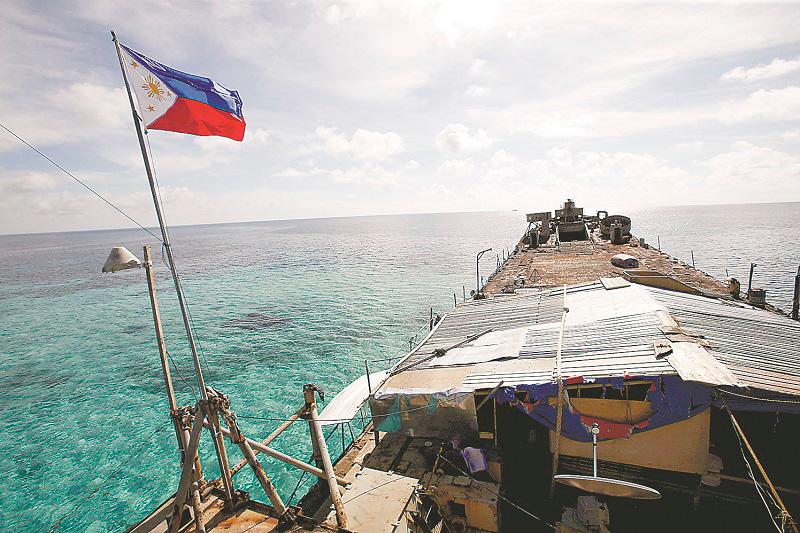MORE than half of Southeast Asians rank aggressive behaviour in the South China Sea as their top geopolitical concern, surpassing the Israel-Hamas conflict.
This is as it should be as the South China Sea is our backyard. However, the same respondents in a State of Southeast Asia Survey 2025 (reported in theSun on April 4) regard climate change and extreme weather events as the region’s biggest challenge.
The irony is that in the Philippines, a frontline country in the path of strong typhoons, 70.9% of respondents ranked climate change as their top concern while in the geopolitical arena, the Philippines looks like it is edging closer to a war with China at America’s behest.
The Philippines has an ongoing territorial dispute with China in the Spratlys and Scarborough Shoal. Clashes between rival coast guard ships have occurred. But there should not necessarily be any conflict to resolve the South China Sea issues with China as Prime Minister Datuk Seri Anwar Ibrahim said last November. He dismissed suggestions that China was “aggressive”, saying that such narratives were the work of “Western capitalists”.
America has been fuelling the conflict in its role as warmonger. Have you noticed that after each clash, it blames China immediately? A peacemaker does not take sides; he mediates disputes.
The US War Department has drawn up contingency plans for military conflict with China, upgrading its military command in Japan to a new “war-fighting headquarters” and deployment of a new anti-ship missile system in the Philippines.
The Philippines is bolstering its military strength with purchases of US F-16 fighter jets and the mid-range Typhoon missile system. It is also buying India’s Akash surface-to-air missile system.
Four months ago, the US defence secretary took issue with China’s territorial claims to any island in the South China Sea. How does he justify the American territories of Guam, the Northern Mariana Islands and Wake Island in the Western Pacific, which is next door to the Philippines but one planet away from California?
These islands are of huge strategic importance for US military power projection with air force, naval and missile bases in Guam; a US Marine rapid deployment force in the Northern Mariana Islands; and a logistics outpost on Wake Island. They serve as backup for instant strike forces based in Japan and the Philippines.
How does America justify Britain’s ownership of the Falkland Islands and Diego Garcia island? Falklands lie off Argentina’s shores but one planet away from the British Isles. In 1982, the two nations fought a war that Britain won and retained ownership.
In the Indian Ocean, Britain exercises sovereignty over Diego Garcia island, which is two continents away from the British Isle. It has a military base, which is under American control and home to long-range bombers targetted at China.
What about New Caledonia in the southwest Pacific Ocean? New Caledonia lies just 1,210km east of Australia but is three continents away from France, which owns them.
Western media continually publish the lie that China has absolutely no right by international law to islands and shoals in the South China Sea. In fact, the prestigious Manila Times wrote last May that “this lie has been masterfully disseminated by the US to demonise China as part of its ‘Pivot to Asia’ policy started in 2009”.
This colossal lie is that China has been intruding into the Philippines’ exclusive economic zone (EEZ) and trampling over the Philippines’ sovereignty. But the EEZ was invented through an international treaty that took effect only in 1994. Unlike the territorial sea, over which a state has absolute sovereignty, an EEZ confers only limited rights to the coastal state.
EEZs, therefore, cannot negate the sovereignty claims of China or any other country, just as Manila’s EEZ cannot claim sovereignty or even sovereign rights over parts of Indonesia and Sabah just because it reaches these areas, the Times said. America’s EEZ, measured from its baselines in Florida, reaches the Cuban coast and the Bahamas but it does not claim it has sovereign rights in these areas.
The dispute in the Spratlys and Scarborough Shoal is about conflicting claims of sovereignty, not EEZs. China, Vietnam, Taiwan and the Philippines each have powerful arguments for their claims of sovereignty over the disputed areas. These territorial claims were made in the 18th century by China and Vietnam, and in Manila’s case in 1978 when it unilaterally declared that the Philippines had legal, historical and equitable grounds to annex and occupy the islands.
China’s claim is that the areas encompassed by Philippine EEZs have been its sovereign territory that it calls Nansha Qundao or Spratly Islands. China’s formal administration of these islands started in the 18th century, evidenced by the fact that Nansha and three other archipelagos have been on its official maps.
Manila Times further reported that former associate justice of the Philippine Supreme Court Antonio Tirol Carpio stated the correct position when he declared in 2023 that Manila’s disputes with China “remain unresolved since the United Nations Convention on the Law of the Sea governs only maritime disputes and not territorial disputes.
There is no treaty providing for a compulsory dispute settlement mechanism for the territorial dispute in the SCS”.
The Manila Times exposed another Western lie that China’s territorial claims are based on a nine-dash line, a series of dashes drawn around the South China Sea that encroaches on the Philippines’ EEZ. China has never declared that the nine-dash line is the basis for its claims of sovereignty.
The Manila Times wrote: “In 1948, the Chinese government published the map of the location of the South China Sea Islands. Both maps placed under China’s sovereignty what are now known as the Nansha Islands (Spratlys), the Dongsha Islands (Pratas), the Xisha Islands (Paracels) and the Zhongsha Islands (Macclesfield Bank).” This was a year before communist rule.
One proof that China’s claims are not based on the nine-dash line, the Manila Times said, is the fact that the Philippines’ Malampaya Gas field from which natural gas has been extracted since 2002, providing 40% of Luzon’s power requirements, is within the nine-dash line. Yet, China has never protested that the Philippines has been extracting gas from Malampaya since 2002.
Manila Times explained why China takes firm action in the Spratlys and Scarborough Shoal whenever Philippine coast guard or naval ships get too close. The defence of Chinese territory looms large in the Chinese people’s consciousness because of its “Century of Humiliation” when Western powers and Japan grabbed huge swaths of its territory, wrote Manila Times.
Why does the US single out China to attack? Possibly because America is in the decline stage of a long-term three-phase cycle that Ray Dalio, founder of one of the largest and most successful hedge funds in the world – Bridgewater Associates, describes in his book The Changing World Order: Why Nations Succeed and Fail (2021).
Ray describes several indicators revealing that America may be in late-stage decline while still dominant. These indicators include political division, decline in trade competitiveness and productivity growth, and decline in global leadership. Three big forces to watch are high debt levels, large wealth and value gaps, and rising conflict with China.
Fearing its own decline, America lashes out at the rest of the world, especially China, which it sees as its biggest threat. This may explain President Donald Trump’s baseline 10% tariff on all countries, including Heard Island and McDonald Islands in the Indian Ocean near Antarctica that are populated only by pigeons.
The tariff imposition on pigeons was defended by Agriculture Secretary Brooke Rollins, who responded when questioned over it that it was an act of patriotism. “We live under a tariff regime from other countries. We have too long ceded the idea that America goes first,” she said.
Here is where Malaysia has to step up as the current Asean chair and forcefully advise the Philippines to back away from calling China an aggressor while portraying itself as the victim. Malaysia should utilise Sarawak’s gospel familiarity to remind Manila of its Christian depth.
“You’re blessed when you can show people how to cooperate instead of compete or fight,” says Jesus (Matthew 5:9). When the enemy accosts you, “do not lose a minute. Make the first move; make things right with him” (Matthew 5:25). “No more tit-for-tat. Live generously” (Matthew 5:42).
Tell America that the threat to its survival comes from climate change and not from China. On April 8, Trump unleashed yet another war on the world. The tariff war president signed a sweeping executive order to “stop the enforcement of state laws” on climate change. As the move is aimed at reviving the coal industry, Trump may have signed a climate death warrant.
Malaysia has to advise China as well. Tone down militarily defensive actions as they tarnish its public image and instead initiate joint cooperation with Manila in fisheries and other mutually beneficial projects.
To conclude our foray into the negative impact of geopolitical strife on climate action, it is worth noting that Britain, which owns the Turks and Caicos Islands in the Caribbean Sea, has a dispute with the Dominican Republic, which has extended its EEZ to cover a rock called Mouchoir Bank and claims sovereignty over it – a claim that Britain rejects.
Joachim Ng champions interfaith harmony.
Comments: letters@thesundaily.com










